案例:员工流失是困扰企业的关键因素之一,在这次的分析中我将分析以下内容:
对一些重要变量进行可视化及探索分析,收入,晋升,满意度,绩效,是否加班等方面进行单变量分析
分析员工流失的因素,探索各个变量的影响度
构建有效的模型来预测员工是否会离职
数据集主要分析的字段
## Attrition 是否离职 需要预测的结果变量 ## Gender 性别 ## Age 年龄 ## Education 学历 ## NumCompaniesWorked 任职过的企业数量 ## TotalWorkingYears 工作年限 ## MaritalStatus 婚姻状况 ## YearsAtCompany 在公司的工作时间 ## JobRole 职位 ## JobLevel 职位等级 ## MonthlyIncome 月薪 ## JobInvolvement 工作投入程度 ## PerformanceRating 绩效评分 ## StockOptionLevel 员工的股权等级 ## PercentSalaryHike 涨薪百分比 ## TrainingTimesLastYear 上一年培训次数 ## YearsSinceLastPromotion 距离上次升值的时间 ## EnvironmentSatisfaction 环境满意度 ## JobSatisfaction 工作满意度 ## RelationshipSatisfaction 关系满意度 ## WorkLifeBalance 生活和工作的平衡度 ## DistanceFromHome 公司和家庭的距离 ## OverTime 是否要加班 ## BusinessTravel 是否要出差
1.导入包
library(ggplot2)
library(grid)
library(gridExtra)
library(plyr)
library(rpart)
library(rpart.plot)
library(randomForest)
library(caret)
library(gbm)
library(survival)
library(pROC)
library(DMwR)
library(scales)
2.导入数据集并查看
Attr.df <- read.csv('E:\Udacity\Data Analysis High\R\R_Study\employee.csv',header=T,encoding = 'UTF-8') head(Attr.df) summary(Attr.df)
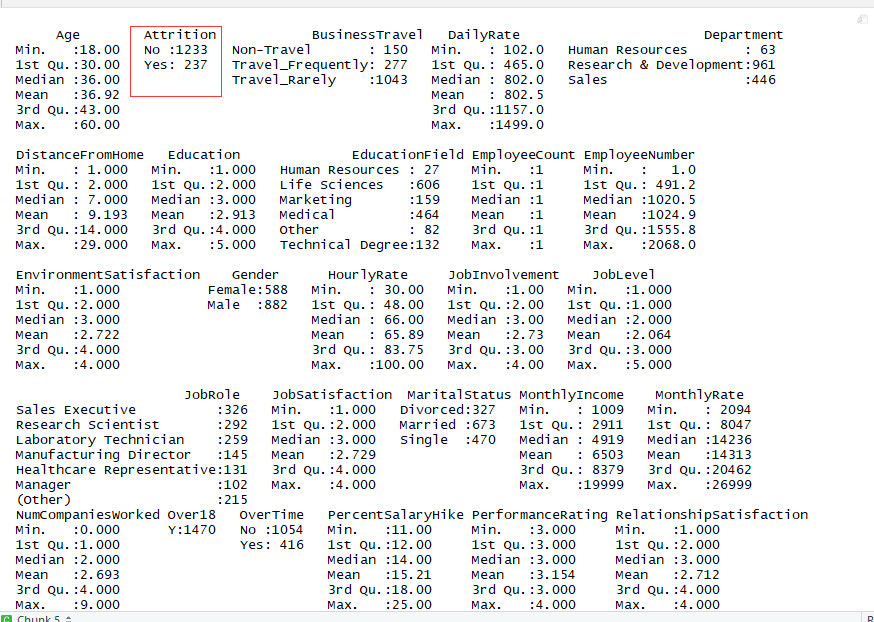
结论:离职率大概在1:5左右
企业的员工的平均年龄在36,37岁左右
月薪的大概是在4900美元,这里采用中位数,平均数会引起偏差
3.单变量分析
3.1探索性别,年龄,工龄,企业数量,在公司的时限的分析
# 离职员工年龄的分布 g1 <- ggplot(Attr.df,aes(x=Age,fill=Attrition))+ geom_density(alpha=0.7) # 离职员工工作过的企业数量的关系 g2 <- ggplot(Attr.df,aes(x=NumCompaniesWorked,fill=Attrition))+ geom_density(alpha=0.7) # 离职员工工龄的分布 g3 <- ggplot(Attr.df,aes(x=YearsAtCompany,fill=Attrition))+ geom_density(alpha=0.7) # 离职员工总体工作年限的分布 g4 <- ggplot(Attr.df,aes(x=TotalWorkingYears,fill=Attrition))+ geom_density(alpha=0.7) grid.arrange(g1,g2,g3,g4,ncol=2,nrow=2)

结论:
1.年龄较低的员工的离职率较高,主要集中在30岁以下的员工
2.工作过的企业数量越多越容易离职
3.在公司工作的时间越久,越不容易离职
4.工龄低的员工离职的几率比较大
3.2性别,职位等级,教育背景,部门的分析
# 离职员工的性别分布 g5 <- ggplot(Attr.df, aes(x= Gender,fill = Attrition)) + geom_bar(position = "fill") + labs(y="Percentage") + scale_y_continuous(labels=percent) # 离职员工的职位等级分布
g6 <-ggplot(Attr.df, aes(x= JobLevel,fill = Attrition)) +
geom_bar(position = "fill") + labs(y="Percentage") +
scale_y_continuous(labels=percent)
# 离职员工的教育背景分布
g7 <- ggplot(Attr.df, aes(x= Education,fill = Attrition)) +
geom_bar(position = "fill") + labs(y="Percentage") +
scale_y_continuous(labels=percent)
# 离职员工的部门分布
g8 <- ggplot(Attr.df, aes(x= Department,fill = Attrition)) +
geom_bar(position = "fill") + labs(y="Percentage") +
scale_y_continuous(labels=percent) grid.arrange(g5, g6, g7, g8, ncol = 2, nrow = 2)
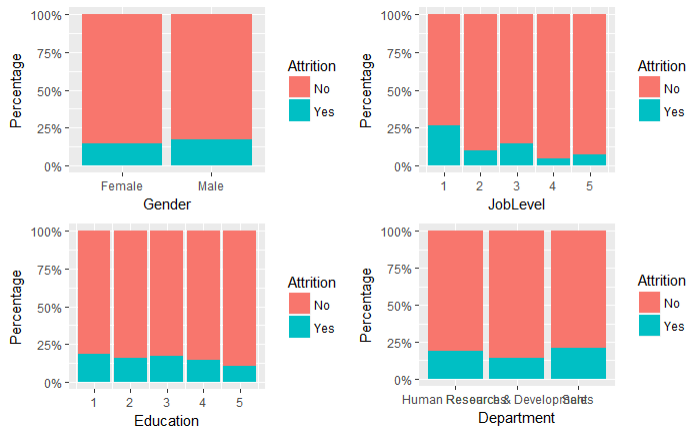
结论:
1.男性的离职率比女性稍高
2.等级越高离职的可能性越小,但是主要集中1级别的职场新人
3.学历和离职率没有太大的关联
4.销售部门相对于其他两个部门离职率较高
3.3 探索涨薪比例,培训次数,每年晋升,员工股权的分析
# 离职员工与涨薪比例的关系 g11 <- ggplot(Attr.df, aes(x = PercentSalaryHike, fill = Attrition)) + geom_density(alpha = 0.7) # 离职员工与培训次数的关系 g12 <- ggplot(Attr.df, aes(x= TrainingTimesLastYear, group=Attrition)) + geom_bar(aes(y = ..prop.., fill = Attrition), stat="count", alpha = 0.7,position = "identity",color="black") + labs(y="Percentage") + scale_y_continuous(labels=percent) # 离职员工的与每年晋升的关系 g13 <- ggplot(Attr.df, aes(x = YearsSinceLastPromotion, fill = Attrition)) + geom_density(alpha = 0.7) # 离职员工与股票期权的关系 g14 <- ggplot(Attr.df, aes(x= StockOptionLevel, group=Attrition)) + geom_bar(aes(y = ..prop.., fill = Attrition), stat="count", alpha = 0.7,position = "identity",color="black") + labs(y="Percentage") + scale_y_continuous(labels=percent) grid.arrange(g11, g12, g13, g14, ncol = 2)
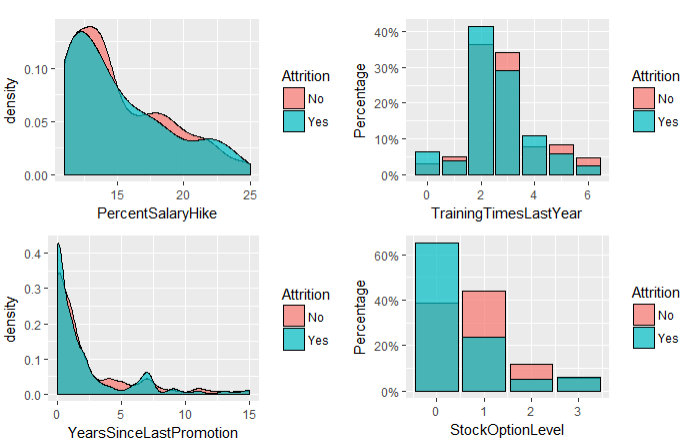
结论:
1.没有涨薪计划的员工流失率较高
2.培训次数和离职率没有太大的影响
3.没有晋升的员工离职率较高
4.没有股权的员工流失率较大
3.4探索工作满意度,同事满意度,环境满意度的分析
# 离职员工与工作满意度的关系 g15 <- ggplot(Attr.df, aes(x= JobSatisfaction, group=Attrition)) + geom_bar(aes(y = ..prop.., fill = Attrition), stat="count", alpha = 0.7,position = "identity",color="black") + labs(y="Percentage") + scale_y_continuous(labels=percent) # 离职员工与同事满意度的关系 g16 <- ggplot(Attr.df, aes(x= RelationshipSatisfaction, group=Attrition)) + geom_bar(aes(y = ..prop.., fill = Attrition), stat="count", alpha = 0.7,position = "identity",color="black") + labs(y="Percentage") + scale_y_continuous(labels=percent) # 离职员工与工作环境满意度的关系 g17 <- ggplot(Attr.df, aes(x= EnvironmentSatisfaction, group=Attrition)) + geom_bar(aes(y = ..prop.., fill = Attrition), stat="count", alpha = 0.7,position = "identity",color="black") + labs(y="Percentage") + scale_y_continuous(labels=percent) grid.arrange(g15, g16,g17, ncol = 3)

结论:满意度越高越不容易离职
3.5探索加班,工作生活的平衡性,是否需要出差,家庭距离之间的关系
# 离职员工和加班之间的关系 g18 <- ggplot(Attr.df, aes(x= OverTime, group=Attrition)) + geom_bar(aes(y = ..prop.., fill = Attrition), stat="count", alpha = 0.7,position = "identity",color="black") + labs(y="Percentage") + scale_y_continuous(labels=percent) # 离职员工和工作生活之间的关系 g19 <- ggplot(Attr.df, aes(x= WorkLifeBalance, group=Attrition)) + geom_bar(aes(y = ..prop.., fill = Attrition), stat="count", alpha = 0.7,position = "identity",color="black") + labs(y="Percentage") + scale_y_continuous(labels=percent) # 离职员工和出差之间的关系 g20 <- ggplot(Attr.df, aes(x= BusinessTravel, group=Attrition)) + geom_bar(aes(y = ..prop.., fill = Attrition), stat="count", alpha = 0.7,position = "identity",color="black") + labs(y="Percentage") + scale_y_continuous(labels=percent) # 离职员工和上班距离之间的关系 g21 <- ggplot(Attr.df,aes(x=DistanceFromHome,fill=Attrition))+ geom_density(alpha=0.7) grid.arrange(g18, g19,g20,g21, ncol = 2)
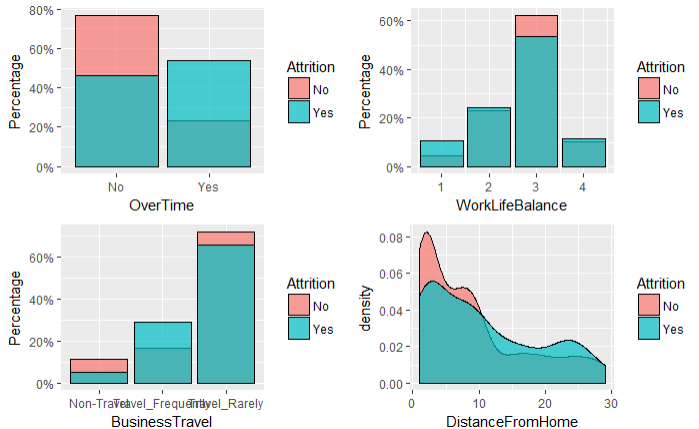
结论:
1.加班越多离职率越高
2.认为工作和生活协调为1的员工工离职率较高
3.经常出差的员工离职率较高
4.距离上班地点越远的员工离职率较高
3.6月薪,职位等级和离职率的关系
# 离职员工和月薪的关系 g9 <- ggplot(Attr.df,aes(x=MonthlyIncome,fill=Attrition))+ geom_density(alpha=0.7) # 离职员工与职位等级的关系 g10 <- ggplot(Attr.df, aes(x= JobInvolvement, group=Attrition)) + geom_bar(aes(y = ..prop.., fill = Attrition), stat="count", alpha = 0.7,position = "identity",color="black") + labs(y="Percentage") + scale_y_continuous(labels=percent) grid.arrange(g9, g10, ncol = 2)
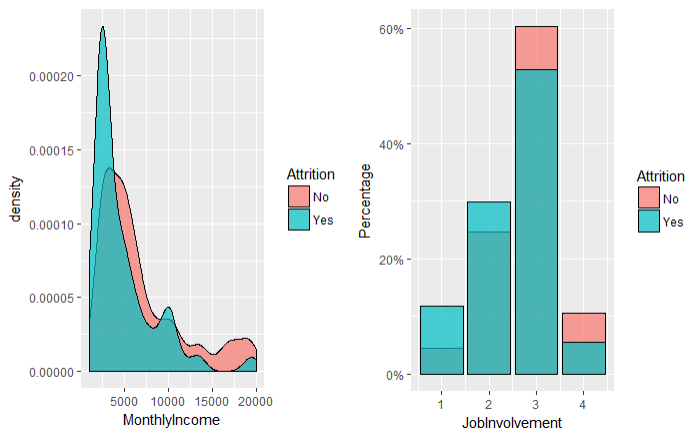
结论:
1.月薪低的员工容易离职
2.职位级别低的离职率较高,但不是很明显
3.6进一步分析月薪和职位级别的关系
ggplot(Attr.df,aes(x=JobInvolvement,y=MonthlyIncome,group=JobInvolvement))+ geom_boxplot(aes(fill=factor(..x..)),alpha=0.7)+ theme(legend.position = 'none',plot.title = element_text(hjust = 0.5))+ facet_grid(~Attrition)+ggtitle('Attrition')

结论:可以明显的得出收入的高低并不是影响员工离职的最主要的因素,如果付出和回报不成正比,会有极大的员工流动
4.建模
4.1决策树
# 去除数据集中没有必要的因子 levels(Attr.df$JobRole) <- c("HC", "HR", "Lab", "Man", "MDir", "RsD", "RsSci", "SlEx", "SlRep") levels(Attr.df$EducationField) <- c("HR", "LS", "MRK", "MED", "NA", "TD") Attr.df <- Attr.df[c(-9,-10,-22,-27)] # 把数据集划分成训练集和测试集 n <- nrow(Attr.df) rnd <- sample(n,n*0.7) train <- Attr.df[rnd,] test <- Attr.df[-rnd,] # 建模 dtree <- rpart(Attrition~.,data=train) preds <- predict(dtree,test,type='class') rocv <- roc(as.numeric(test$Attrition),as.numeric(preds)) rocv$auc prop.table(table(test$Attrition,preds,dnn = c('Actual','Predicted')),1) dtreepr <- prune(dtree,cp=0.01666667) predspr <- predict(dtreepr,test,type='class') rocvpr <- roc(as.numeric(test$Attrition),as.numeric(predspr)) rocvpr$auc rpart.plot(dtreepr,type=4,extra=104,tweak = 0.9,fallen.leaves = F,cex = 0.7)
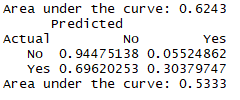
结论:AUC的值0.624比较低,而且灵敏度0.3说明该模型并不能很好的预测离职
4.2随机森林
set.seed(2343) fit.forest <- randomForest(Attrition~.,data=train) rfpreds <- predict(fit.forest,test,type='class') rocrf <- roc(as.numeric(test$Attrition),as.numeric(rfpreds)) rocrf$auc

结论:需要进行优化
4.3GBM
set.seed(3443) # 定义10折交叉验证用于控制所有的GBM模型训练 ctrl <- trainControl(method = 'cv',number=10,summaryFunction = twoClassSummary,classProbs = T) gbmfit <- train(Attrition~.,data=train,method='gbm',verbose=F,metric='ROC',trControl=ctrl) gbmpreds <- predict(gbmfit,test) rocgbm <- roc(as.numeric(test$Attrition),as.numeric(gbmpreds)) rocgbm$auc

结论:需要进行优化
4.4优化GBM模型
# 设置和之前一样的种子数 ctrl$seeds <- gbmfit$control$seeds # 加权GBM,设置权重参数,平衡样本 model_weights <- ifelse(train$Attrition == 'No', (1/table(train$Attrition)[1]), (1/table(train$Attrition)[2])) weightedleft <- train(Attrition ~ ., data=train, method='gbm', verbose=F, weights=model_weights, metric='ROC', trControl=ctrl) weightedpreds <- predict(weightedleft,test) rocweight <- roc(as.numeric(test$Attrition),as.numeric(weightedpreds)) rocweight$auc # 向上采样 ctrl$sampling <- 'up' set.seed(3433) upfit <- train(Attrition ~., data = train, method = "gbm", verbose = FALSE, metric = "ROC", trControl = ctrl) uppreds <- predict(upfit, test) rocup <- roc(as.numeric(test$Attrition), as.numeric(uppreds)) rocup$auc # 向下采样 ctrl$sampling <- 'down' set.seed(3433) downfit <- train(Attrition ~., data = train, method = "gbm", verbose = FALSE, metric = "ROC", trControl = ctrl) downpreds <- predict(downfit, test) rocdown <- roc(as.numeric(test$Attrition), as.numeric(downpreds)) rocdown$auc prop.table(table(test$Attrition, weightedpreds, dnn = c("Actual", "Predicted")),1)

结论:选取第二车向上采样的模型,精确度提升到72%,灵敏度提升到62%
5 使用模型来预测离职
5.1查看哪些因素影响员工离职
varImp(upfit)

结论:影响员工离职的首要因素:加班,月薪,在公司工作的年限,是否有股权,年龄等因素
5.2预测工作投入高,月薪少的员工的离职率
upfitprobs <- predict(upfit,test,type = 'prob') test$Prediction <- upfitprobs$Yes ggplot(test, aes(x=MonthlyIncome,y=Prediction,color=factor(JobInvolvement)))+ geom_point(alpha=0.7)+ geom_smooth(method = 'lm')+ facet_wrap(~JobInvolvement)+ theme(legend.position = 'none')+ ggtitle('JobInvolvement')+ theme(plot.title = element_text(hjust = 0.5))

结论:图4表示工作投入高,但是月薪低的员工反而是不容易离职的,可能是因为对企业有归属感或者是企业的其他福利待遇较好
5.3预测那些职位的离职率最高
ggplot(test,aes(x=JobRole,y=Prediction,fill=JobRole))+ geom_boxplot(alpha=0.5)+ theme(legend.position = 'none')+ scale_y_continuous(labels = percent)

结论:销售的离职率相对与其他的离职率较大
总结:
1.员工离职的很大原因是因为加班,或者是付出和回报不成正比导致的
2.在某些生活方面,比如频繁出差,上班路程较远也是员工离职的一个次要原因
3.相比于高薪的吸引力,员工更加认可股权的享有,享有股权分红的员工更不容易离职
4.年龄,在公司的年限和工龄也是影响员工离职的一些重要的指标
5.如果有更多的真实数据集,模型可能会更加准确
github:https://github.com/Mounment/R-Project